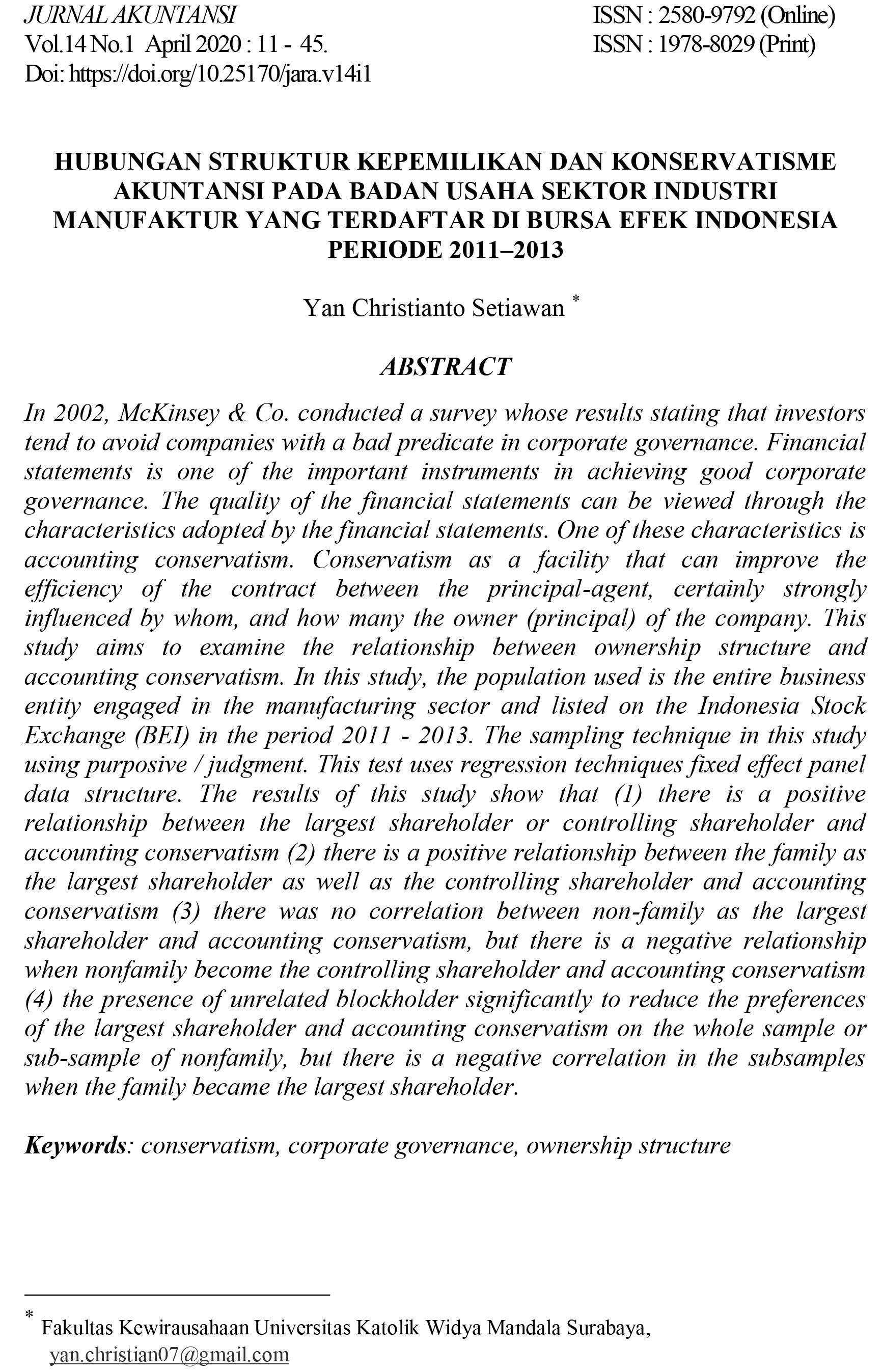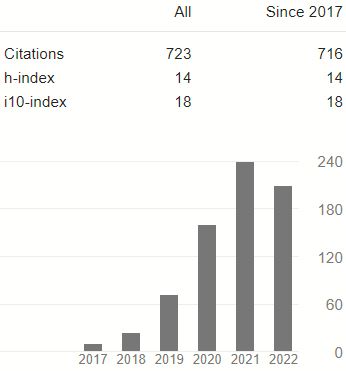HUBUNGAN STRUKTUR KEPEMILIKAN DAN KONSERVATISME AKUNTANSI PADA BADAN USAHA SEKTOR INDUSTRI MANUFAKTUR YANG TERDAFTAR DI BURSA EFEK INDONESIA PERIODE 2011 – 2013
DOI:
https://doi.org/10.25170/jak.v14i1.936Keywords:
conservatism, corporate governance, ownership structureAbstract
In 2002, McKinsey & Co. conducted a survey whose results stating that investors tend to avoid companies with a bad predicate in corporate governance. Financial statements is one of the important instruments in achieving good corporate governance. The quality of the financial statements can be viewed through the characteristics adopted by the financial statements. One of these characteristics is accounting conservatism. Conservatism as a facility that can improve the efficiency of the contract between the principal agent, certainly strongly influenced by whom and how many the owner (principal) of the company. This study aims to examine the relationship of ownership structure and accounting conservatism. In this study, the population used is the entire business entity engaged in the manufacturing sector and listed on the Indonesia Stock Exchange (BEI) in the period 2011 - 2013. The sampling technique in this study using purposive / judgment. This test uses regression techniques fixed effect panel data structure. The results of this study show that (1) there is a positive relationship between the largest shareholder or controlling shareholder and accounting conservatism (2) there is a positive relationship between the family as the largest shareholder as well as the controlling shareholder and accounting conservatism (3) there was no correlation between non-family as the largest shareholder and accounting conservatism, but there is a negative relationship when nonfamily become the controlling shareholder and accounting conservatism (4) the presence of unrelated blockholder significantly to reduce the preferences of the largest shareholder and accounting conservatism on the whole sample or sub-sample of nonfamily , but there is a negative correlation in the sub samples when the family became the largest shareholder.
Keywords : conservatism, corporate governance, ownership structure.
References
Arifin, Z. (2003). Masalah Agensi dan Mekanisme Kontrol pada Perusahaan dengan Struktur Kepemilikan Terkonsentrasi yang Dikontrol Keluarga: Bukti dari Perusahaan Publik di Indonesia. Disertasi Fakultas Ekonomi Universitas Indonesia.
Basu, S. (1997). The Conservatism Principle and the Asymmetric Timeliness of Earnings. Journal of Accounting and Economics 24, 3-37.
Burkart, M., Panunzi, F., & Shleifer, A. (2003). Family Firms. The Journal of Finance, 2167-2201.
Cao, Y., Lin, L., & Sun, Z. (2005). The Link Between Earnings Conservatism and The Control Power of Corporation. Economic Management (14), 34-42.
Claessens, S., & Djankov, S. (1999). The Separation of Ownership and Control in East Asians Corporations. Journal of Financial Economics, 81-112.
Cullinan, C. P., Wang, F., Wang, P., & Zhang, J. (2012). Ownership Structure and Accounting Conservatism in China. Journal of International Accounting, Auditing, and Taxation, 21, 1-14.
Demsetz and Lehn, 1985. The structure of corporate ownership: causes and consequences. Journal of Political Economy, 93(6), pp. 1155-1177.
Ghozali, Imam. 2013. Analisis Multivariat dan Ekonometrika, Teori, Konsep, dan Aplikasi dengan EViews 8. Semarang: Badan Penerbit Universitas Diponegoro.
Hughes, J. P. (2005). Ultimate control and corporate value: Evidence from the UK. Financial Reporting, Regulation and Governance, 4, 1–23.
Kets, de Vries Manfried. (1993). The Dynamics of Family – Controlled Firms : The Good News and The Bad News. Organizational Dynamics, Vol. 21, Issue 3, pp. 59 – 71.
LaFond, R., & Roychowdhury, S. (2008). Managerial ownership and accounting conservatism. Journal of Accounting Research, 46, 101–135.
LaPorta, R., Lopez-De-Silanes, F., & Shleifer, A. (1999). Corporate ownership around the world. The Journal of Finance, 54, 471–517.
Nordberg, Donald. (2011). Corporate Governance : Principles and Issues. London : Sage
Tomasic, R. and Andrews, N. (2007). Minority Shareholders Protection in China’s Top 100 Listed Companies. The Australian Journal of Asian Law, Vol. 9, No. 1, pp. 88 – 119.
Wolk, H. I, and Michael G. Tearney, 1997. Accounting Theory : A Conceptual and Institutional Approach 4th ed. Ohio, South – Western College Publishing.

Downloads
Published
Issue
Section
License
Authors who publish with this journal agree to the following terms:
- Authors retain copyright and grant the journal right of first publication with the work simultaneously licensed under a Creative Commons Attribution-ShareAlike 4.0 International License that allows others to share the work with an acknowledgment of the work's authorship and initial publication in this journal.
- Authors are able to enter into separate, additional contractual arrangements for the non-exclusive distribution of the journal's published version of the work (e.g., post it to an institutional repository or publish it in a book), with an acknowledgment of its initial publication in this journal.
- Authors are permitted and encouraged to post their work online (e.g., in institutional repositories or on their website) prior to and during the submission process, as it can lead to productive exchanges, as well as earlier and greater citation of published work.














